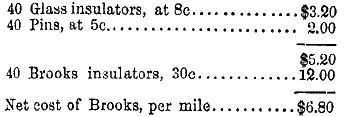[Trade Journal]
Publication: The Telegrapher
New York, NY, United States
vol. 7, no. 19, p. 145, col. 1-2
Original Articles.
How Not to Do It.
IN making a short trip through the Eastern States, a week or two since, we noticed a gang of men at work putting up a new through wire for the Western Union Company, along, what is known as the "Shore route" between New York and Boston, via New Haven, New London and Providence. This new wire is of No. 7 gauge, 0.180 inch diameter, weighing about 450 lbs. per mile, and having a mileage resistance of about 13.5 units. Most of the present wires between these two cities are No. 9, and their resistance will probably average 19 or 20 units per mile when in good condition.
It has frequently been pointed out, by writers on the subject in these columns and elsewhere, that the practical working value of a telegraph line is the difference or margin between the joint resistence [sic] resistance of the conductor and the insulators and that of the insulators alone; therefore, the working of lines can be improved on two ways - by increasing the resistance of the insulation or by decreasing the resistance of the conductor. The practical question is, by which method can the greatest result be secured at the least expense? The Western Union Company seem to have decided in favor of the second method, but it is somewhat doubtful whether this decision is a wise one.
A No. 9 English galvanized wire costs about 7-3/4 cts. per pound, or about $23.50 per mile, and a No. 7 wire 7-1/4 cents per pound, or say $32.50 per mile. Allowing that it costs no more to string the heavy wire, the difference in cost per mile will string $9.00. The insulation remaining the same, the conductivity of the large wire will be greater than that of the smaller one, in proportion to their weight per mile. No. 9 weighs 303 lbs. and-No. 7,448 lbs. per mile, therefore the larger wire will work 49 per cent. better in bad weather, with the same insulation, at an increased cost of $9 per mile expended in the original construction. It should also be taken into consideration that the consumption of battery material in working such a line will be increased nearly in proportion to the conductivity of the wire.
A considerable number of Brooks' paraffine insulators, which have been put up in this city for nearly three years, now show an insulation resistance averaging in no case less than one hundred times that of the common glass insulator, such as is used by the Western Union Company on the new wire above referred to. Suppose that instead of putting up the large No. 7 wire they had used a No. 9 wire, with the Brooks paraffine insulator. The difference in cost would have been as follows per mile:
 |
Now, as the working capacity of the line depends upon the ratio of its conductivity to its insulation, let us see how the comparison stands in this respect. The average resistance of the best glass insulators in heavy storms does not exceed 9,000,000 ohms. - (Farmer.) This would give for the No. 7 iron wire a conductivity resistance of 13.5 ohms per mile, and an insulation resistance in round numbers of 202,500 ohms. Ratio of mileage conductivity to insulation as 1 to 15,000. With the No. 9 wire and Brooks insulators we have a conductivity resistance say of 20 ohms per mile, and an insulation resistance of at least 2,000,000 ohms per mile - the ratio being as 1 to 100,000 - giving a circuit that will work more than 600 per cent. better than the large wire with the common glass insulation, at an increased cost per mile over the ordinary construction of only $6.80 instead of $9.00. If any considerable number of those large wires were to be strung the proportionate cost would be much greater, as the poles and other parts of the structure would require to be made much stronger and heavier.
Any one who is practically acquainted with the performance of the Brooks insulators, will admit that their excellence has been, if anything, considerably underrated in the above calculation.
The absurdity of depending solely upon increased conductivity, to ensure lines working in bad weather, can hardly fail to be evident to any reflecting mind upon a moment's consideration, As long as all improved insulators were as yet an experiment it was perfectly proper to make the best of glass, by every possible means, but that day has passed. For the enlightened and economical telegraphic engineer of the present day a better way is open.
By their action in this case the electricians of the Western Union Company virtually say: "We cannot work a No. 9 wire with certainty from New York to Boston on a wet day, because from 75 to 90 per cent. of the current escapes from the wire through the glass insulators. We give up the idea of improving the insulation as a problem far beyond our knowledge and capacity. Let us manufacture enough electricity to supply the insatiate cravings of those insulators, and still have a little left to do our own work with, even if we have to use Grove batteries in double series, and finally let us put up a wire large enough to carry the whole amount."
The careful reader of this article knows the result of this system already. The Western Union electricians will find it out probably during the rains of next April, and the stockholders about the time the next dividend is due.
